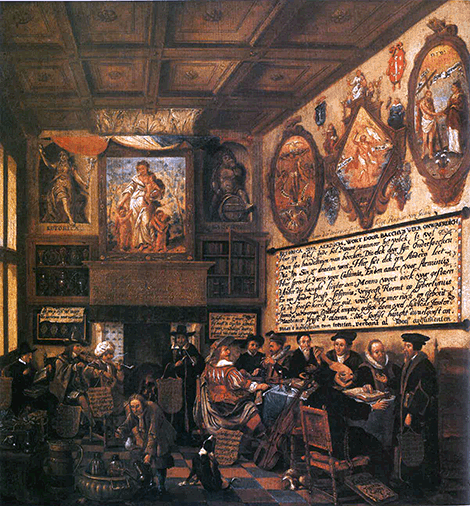|
Origins
Outside of the Netherlands and occasional brief mentions in
Theatre History and the history of the Reformation, the Chambers of Rhetoric
are practically unknown. However, as these merchants and artisans gathered
together in their meeting halls to share a collegial pint as they labored
together to create a new play or competed in poetry contests, they were
contributing to a revolutionary cultural movement that would destabilize power
structures that had ruled over a thousand years in there era and still echo
today. Quietly – without conservative forces to denounce the practice or
reformers to champion it -- the
Rederjikers produced generations of literate middle-class who were practiced
accomplished public speakers well-schooled in the essential elements of
rhetoric and logical appeal. It is no wonder that Wittenberg, ground-zero for
the Reformation, a cultural blast that would shake the foundations of Early
Modern Europe, lay within comfortable travel distance of the largest rederijkerskamers.
|
 |
|
The Rederyker
Kamers, Camer van Rhetorica, or "Chambers of Rhetoric"
were a phenomenon of the fifteenth, sixteenth and seventeenth centuries in
northern France and the Low Countries. The Chambers were societies devoted to
the creation and performance of poetry, music, and plays. In "Literature
of the Low Countries" Reinder P. Meijer claims that the origin of the
Chambers was not Dutch, but French. "Associations of Rhetoriquers"
existed in the north of France as early as the twelfth century. These
Associations were popular with the Burgundian court in the fifteenth century. Taking inspiration from these French dramatic societies, the
early chambers were organized more along the lines of medieval trade guilds.
Each had a name, slogan, and blazoen
(emblem). Each chamber had code of rules for membership enforced by fines. Each
had officers, paid employees, and an artistic director.
As a not insignificant by-product of learning how to best to
accomplish this goal, the rederijkers had to become skilled actors, public speakers,
clowns, artisans, entertainers, debaters, and playwrights. They had to teach each other how to read,
write, and speak in public in a manner that was confident, clever, and
entertaining. The rederikers started out only intending to create parades,
plays, and pageants that would do honor to their city. Almost by accident, they
produced a new type of educated, questioning European citizen who would turn Medieval
assumptions about class and power on their heads. |
|
 Chambers functioned in coordination with town councils and
local nobility to organize the necessary elements to put together civic
festivals, ceremonies, and pageants.
Chambers functioned in coordination with town councils and
local nobility to organize the necessary elements to put together civic
festivals, ceremonies, and pageants.